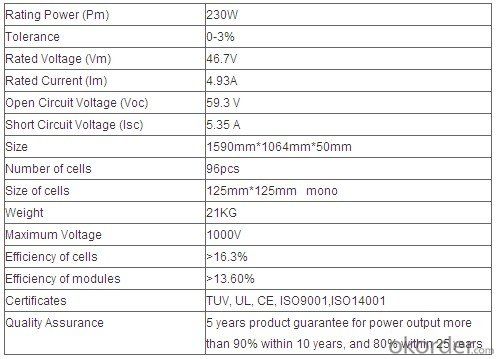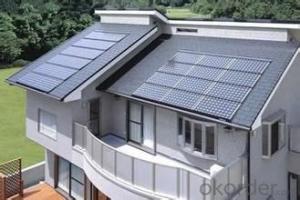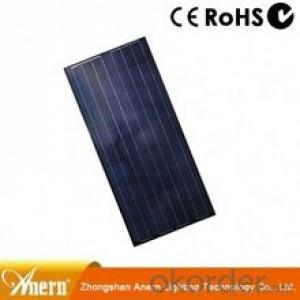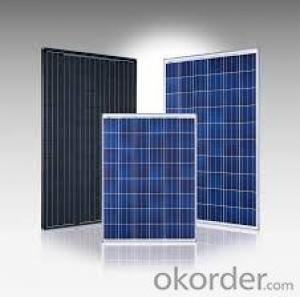Silicon Solar Cell 156mm 2014
- Loading Port:
- China Main Port
- Payment Terms:
- TT OR LC
- Min Order Qty:
- -
- Supply Capability:
- -
OKorder Service Pledge
OKorder Financial Service
You Might Also Like
Quick Details
| Model Number: | |||||
| Material: | Size: | Number of Cells: | |||
| Max. Power: | Weight: | Rating Power (Pm): | |||
| Tolerance: | Rated Voltage (Vm): | Rated Current (Im): | |||
| Open Circuit Voltage (Voc): | Short Circuit Voltage (Isc): | Size of cells: | |||
| Website: |
Packaging & Delivery
| Packaging Detail: | Standard export packing |
| Delivery Detail: | 20days |
Specifications
1)High quality monocrystalline silicon solar cell
2) Competitive prices
3) TUV, UL, IEC61215,IEC61730, CE
monocrystalline silicon solar cell
1,Solar Module is widely used for
1)Microwave/radio repeater stations,
2)Electrification of villages in emote areas,
3)Medical facilities in rural areas,
4)Power source for summer vacation homes,
5)Emergency communication systems
6)Water quality and environmental data monitoring systems
7)Navigation lighthouses, and ocean buoys
8)Pumping systems for irrigation, rural water supplies and livestock watering
9)Aviation obstruction lights
10)Cathodic protection systems
11)Desalination systems
12)Recreational vehicles
13)Railroad signals
14)Sailboat charging systems
2) Product Description

- Q:Can solar cells be used in charging electric bikes?
- Yes, solar cells can be used to charge electric bikes. By connecting solar panels to the bike's battery, the energy from the sun can be converted into electricity, providing a renewable and sustainable source of power for the bike's charging needs.
- Q:How do solar cells affect the aesthetics of a building?
- Solar cells can have a significant impact on the aesthetics of a building. While they provide an eco-friendly and sustainable energy solution, their installation can alter the visual appearance of a structure. The presence of solar panels on rooftops or facades may change the overall design, symmetry, or color scheme of the building. However, advancements in solar technology have led to more aesthetically pleasing options such as solar tiles or solar windows, which seamlessly blend with the architecture and minimize the visual impact. Ultimately, the extent to which solar cells affect the aesthetics of a building depends on the design choices and integration techniques employed.
- Q:How do solar cells generate electricity?
- Solar cells generate electricity through the photovoltaic effect, where sunlight photons excite electrons in the cell's semiconductor material, creating a flow of electric current.
- Q:How are solar cells made?
- Solar cells are typically made using a process called photovoltaic manufacturing, which involves several steps. First, silicon, which is the main material used in solar cells, is extracted from silica, a component of sand. The extracted silicon is then purified and transformed into a crystal structure suitable for solar cell production. These silicon wafers are then cut into thin slices. Next, various layers of conductive materials and anti-reflective coatings are applied to the wafer, creating the necessary electrical properties and enhancing light absorption. Finally, electrical contacts are added to the cell, allowing the generated electricity to be collected and used.
- Q:Can solar cells be used in electric vehicle charging stations?
- Yes, solar cells can be used in electric vehicle charging stations. Solar panels can generate electricity from sunlight, which can then be used to charge electric vehicles. This provides a sustainable and renewable energy source for charging stations, reducing dependency on traditional power grids and reducing carbon emissions.
- Q:Can solar cells be used in disaster response vehicles?
- Yes, solar cells can be used in disaster response vehicles. They can provide a reliable and renewable source of power to charge essential equipment and devices, such as communication systems, lights, and medical equipment. Solar cells are especially useful in remote or off-grid areas where traditional power sources may be disrupted or unavailable during a disaster.
- Q:Can solar cells be used for powering satellites?
- Yes, solar cells can be used for powering satellites. In fact, they are the primary source of power for most satellites in space. Solar cells convert sunlight into electricity, which is stored in batteries for use during periods of darkness or when the satellite is in Earth's shadow.
- Q:Can solar cells be used to power electronic devices?
- Yes, solar cells can be used to power electronic devices. Solar cells convert sunlight into electricity, which can then be used to power various electronic devices such as calculators, smartphones, and even larger appliances like laptops or refrigerators when appropriately connected to the solar cell system.
- Q:What materials are used in solar cells?
- The materials used in solar cells primarily include silicon, which is the most commonly used semiconductor material, along with other elements such as gallium, indium, and selenium. These materials help convert sunlight into electricity through the photovoltaic effect.
- Q:What is the impact of solar cells on job creation?
- Solar cells have had a significant positive impact on job creation, both in the manufacturing and installation sectors. The growing demand for renewable energy has led to a surge in solar cell production, creating new manufacturing jobs and stimulating economic growth. Additionally, the installation and maintenance of solar panels have created numerous job opportunities, especially in the construction and engineering industries. As the solar industry continues to expand, it is expected to further contribute to job creation and foster a sustainable and green economy.
1. Manufacturer Overview |
|
|---|---|
| Location | |
| Year Established | |
| Annual Output Value | |
| Main Markets | |
| Company Certifications | |
2. Manufacturer Certificates |
|
|---|---|
| a) Certification Name | |
| Range | |
| Reference | |
| Validity Period | |
3. Manufacturer Capability |
|
|---|---|
| a)Trade Capacity | |
| Nearest Port | |
| Export Percentage | |
| No.of Employees in Trade Department | |
| Language Spoken: | |
| b)Factory Information | |
| Factory Size: | |
| No. of Production Lines | |
| Contract Manufacturing | |
| Product Price Range | |
Send your message to us
Silicon Solar Cell 156mm 2014
- Loading Port:
- China Main Port
- Payment Terms:
- TT OR LC
- Min Order Qty:
- -
- Supply Capability:
- -
OKorder Service Pledge
OKorder Financial Service
Similar products
New products
Hot products
Hot Searches
Related keywords


























